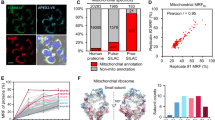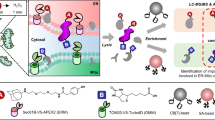Abstract
Protein synthesis is a dynamic process that tunes the cellular proteome in response to internal and external demands. Metabolic labeling approaches identify the general proteomic response but cannot visualize specific newly synthesized proteins within cells. Here we describe a technique that couples noncanonical amino acid tagging or puromycylation with the proximity ligation assay to visualize specific newly synthesized proteins and monitor their origin, redistribution and turnover in situ.
This is a preview of subscription content, access via your institution
Access options
Subscribe to this journal
Receive 12 print issues and online access
$259.00 per year
only $21.58 per issue
Buy this article
- Purchase on Springer Link
- Instant access to full article PDF
Prices may be subject to local taxes which are calculated during checkout



Similar content being viewed by others
References
Dieterich, D.C., Link, A.J., Graumann, J., Tirrell, D.A. & Schuman, E.M. Proc. Natl. Acad. Sci. USA 103, 9482–9487 (2006).
Dieterich, D.C. et al. Nat. Neurosci. 13, 897–905 (2010).
David, A. et al. J. Cell Biol. 197, 45–57 (2012).
Schmidt, E.K., Clavarino, G., Ceppi, M. & Pierre, P. Nat. Methods 6, 275–277 (2009).
Jarvius, M. et al. Mol. Cell. Proteomics 6, 1500–1509 (2007).
Söderberg, O. et al. Nat. Methods 3, 995–1000 (2006).
Pestka, S. Annu. Rev. Microbiol. 25, 487–562 (1971).
Zivraj, K.H. et al. J. Neurosci. 30, 15464–15478 (2010).
Cajigas, I.J. et al. Neuron 74, 453–466 (2012).
Burgin, K.E. et al. J. Neurosci. 10, 1788–1798 (1990).
Femino, A.M., Fay, F.S., Fogarty, K. & Singer, R.H. Science 280, 585–590 (1998).
Battich, N., Stoeger, T. & Pelkmans, L. Nat. Methods 10, 1127–1133 (2013).
Gumy, L.F. et al. RNA 17, 85–98 (2011).
Dresbach, T. et al. J. Biol. Chem. 281, 6038–6047 (2006).
Cohen, L.D. et al. PLoS ONE 8, e63191 (2013).
Chudakov, D.M., Lukyanov, S. & Lukyanov, K.A. Nat. Protoc. 2, 2024–2032 (2007).
Lin, M.Z., Glenn, J.S. & Tsien, R.Y. Proc. Natl. Acad. Sci. USA 105, 7744–7749 (2008).
Turrigiano, G.G., Leslie, K.R., Desai, N.S., Rutherford, L.C. & Nelson, S.B. Nature 391, 892–896 (1998).
Sutton, M.A. et al. Cell 125, 785–799 (2006).
Hinz, F.I., Dieterich, D.C., Tirrell, D.A. & Schuman, E.M. ACS Chem. Neurosci. 3, 40–49 (2012).
Schubert, U. et al. Nature 404, 770–774 (2000).
Kim, S.A., Tai, C.Y., Mok, L.P., Mosser, E.A. & Schuman, E.M. Proc. Natl. Acad. Sci. USA 108, 9857–9862 (2011).
Aakalu, G., Smith, W.B., Nguyen, N., Jiang, C. & Schuman, E.M. Neuron 30, 489–502 (2001).
Banker, G. & Goslin, K. Culturing Nerve Cells (MIT Press, 1990).
tom Dieck, S. et al. Curr. Protoc. Cell. Biol. 56 7.11 (2012).
Link, A.J., Vink, M.K. & Tirrell, D.A. Nat. Protoc. 2, 1879–1883 (2007).
tom Dieck, S. et al. J. Cell Biol. 142, 499–509 (1998).
Acknowledgements
We thank N. Fuerst and A. Staab for the preparation of cultured hippocampal neurons. E.M.S. is funded by the Max Planck Society; an Advanced Investigator award from the European Research Council, Deutsche Forschungsgemeinschaft (DFG) Collaborative Research Center (CRC) 902: Molecular Principles of RNA-based Regulation; DFG CRC 1080: Molecular and Cellular Mechanisms of Neural Homeostasis; and the DFG Cluster of Excellence for Macromolecular Complexes, Goethe University, Frankfurt. D.A.T is funded by US National Institutes of Health grant R01 GM062523.
Author information
Authors and Affiliations
Contributions
S.t.D.: designed, conducted and analyzed experiments and wrote the manuscript. L.K.: designed, conducted and analyzed experiments and edited the manuscript. M.H.: wrote the analysis script and conducted and analyzed experiments. B.N.-A. and I.B.: conducted and analyzed experiments. S.B.: conducted experiments. S.G., K.M. and T.M.: conducted and analyzed experiments. C.H.: designed experiments and edited the manuscript D.A.T.: designed experiments and provided expertise. E.M.S.: designed experiments and wrote the manuscript.
Corresponding author
Ethics declarations
Competing interests
The authors declare no competing financial interests.
Integrated supplementary information
Supplementary Figure 1 Incubation scheme for FUNCAT-PLA and controls for FUNCAT-PLA and Puro-PLA
(a) Scheme of incubation protocol used to label newly synthesized Camk2a, as an exemplar protein, in cultured hippocampal neurons using AHA. (b) Structure of the biotin alkyne tag Acetylene-PEG4-biotin. (c) Upper panel: Full-size images of cells shown in Figure 1b of the main manuscript and additional control conditions: leave-out of anti-biotin antibody, methionine instead of AHA in the incubation medium or addition of the protein synthesis inhibitor Anisomycin (40 µM) all block the signal. Scale bar = 30 µm. (d) Image showing the TGN38 Puro-PLA signal for control conditions without puromycin for the same experiment as shown in Figure 1e of the main manuscript. Scale bar = 20 µm. In all images: nuclei stained with DAPI (blue), dendrites labeled with an anti-MAP2-antibody (magenta) and the PLA-signal (green).
Supplementary Figure 2 Experimental system to test the FUNCAT-PLA dependence on protein synthesis and coincident presence of AHA incorporation and the protein of interest
In these experiments, we optimized the detection of newly synthesized N-Cadherin (NCad) molecules in Lcells, which normally do not express cadherins but were stably transfected with Venus-tagged N-Cadherin. (a) Western blot showing that NCad-Venus cells express the NCad-Venus fusion protein detected by NCad and GFP antibodies, but not endogenous NCad. Lcells express neither NCad nor GFP (Venus). (b) Images of Lcells expressing NCad-Venus (left, Venus fluorescence in green) and wild type (WT) Lcells lacking NCad-Venus expression (nuclei are labeled with DAPI (blue) and the Venus fluorescence is shown in grayscale image in white). Scale bar = 30 µm. (c) Images of anti-N-Cadherin immunocytochemical labeling (red) and Venus fluorescence (green) in a mixed population of WT and NCad-Venus-expressing Lcells. Only cells expressing NCad-Venus show positive antibody labeling for NCad. Scale bar = 30 μm. (d) Images of mixed cell populations treated with AHA (4 mM for 2 h) followed by click-chemistry for fluorescent detection of newly synthesized proteins (FUNCAT) resulted in robust signal in the entire (transfected and non-transfected) population of Lcells (d, upper panel). In contrast, methionine (Met)-treatment led to negligible FUNCAT signal in the population (d, lower panel). Scale bar = 30 μm. (e) Images of mixed cell populations with labeling of the total amount of either NCad-Venus or biotin (AHA) using single antibody PLA. Scale bar = 50 µm. To detect (and titrate) a single antibody, PLAplus and PLAminus probes against the same species are applied.
Supplementary Figure 3 Selectivity and specificity of labeling newly synthesized proteins
To show the dependence of FUNCAT-PLA on the coincident presence of both partners and on protein synthesis we combined the detection of NCad-Venus and newly synthesized molecules following 2 h of AHA treatment in a mixed population using an antibody to Venus (GFP) and one to biotin. (a) FUNCAT-PLA labeling strategy. (b) Images of mixed populations with abundant newly synthesized NCad-Venus (green) in AHA-treated cells (upper panel) but not in Met-treated cells (middle panel) or in presence of Anisomycin (lower panel). Using the endogenous Venus fluorescence (red) as a marker to localize transfected cells we found that within the mixed population of AHA-treated cells, the coincidence PLA signal was detected exclusively in the transfected cells (b-1), not in wild type (WT) cells (b-2). Thus, the coincidence detection system indeed led to significant labeling only when both parts – newly synthesized proteins and the protein of interest - were present. Scale bar = 50 μm; 10 μm in inset. (c,d) Quantification of the signal in both the biological (untransfected WT cells, Met, AHA/Aniso) and technical (omission of one primary antibody) controls using the NCad-biotin (c) or the GFP-biotin combination of primary antibodies (d). Signals are normalized to the mean signal in AHA-treated NCadVenus-expressing cells and shown as mean ± SEM resulting from two - four independent experiments (c: n = 66 - 133, d: n = 8 - 12). All control group values were significantly lower than the values in AHA-treated NCad-Venus cells (ANOVA, Tukey's multiple comparisons test. ***P < 0.0001).
Supplementary Figure 4 Pulse-labeling followed by FUNCAT-PLA reveals distinct spatial patterns for newly synthesized protein species in neurons
Images showing total protein labeling by immunostaining for a variety of example proteins in hippocampal neurons (left double panel) as fluorescence image overlay (left; POI = green) with anti-MAP2 (red) and nuclei stained with DAPI (blue) or the POI channel converted to grey scale for better visualization (right). In the right double panel the corresponding FUNCAT-PLA signal for the same POI in cells treated with AHA (2 h; 15 min chase; AHA panel) or without AHA (Met panel) are displayed. Cells were processed using FUNCAT-PLA with antibodies against the indicated proteins of interest and images converted to representations on white background for better visualization. Close-ups for Bassoon, LaminB and TGN38 are shown in Figure 1 of the main manuscript. Scale bar = 30 μm, MAP2 outline grey, PLA signal red, DAPI blue.
Supplementary Figure 5 Bassoon FUNCAT-PLA signal is present in axons, and comparison of Puro-PLA and single-antibody PLA for bassoon
(a) Images of a neuron showing that pulse-labeled Bassoon is present in axons and accounts for signal that does not overlap with the MAP2-positive somato-dendritic area. Left: merged image of FUNCAT-PLA signal for Bassoon (green), axonal staining (anti-neurofilament Smi312 monoclonal, blue) and dendrites (anti-MAP2, red); nuclei are visualized with DAPI (blue). Arrows indicate examples of sites at which the Bassoon FUNCAT-PLA signal colocalizes with the axonal marker. Hippocampal neurons were labeled with AHA for 2 h and chased for 10 min before performing FUNCAT-PLA labeling. Scale bar = 20 µm. (b) Graph of the comparison of the ratio of integrated signal intensity for Puro-PLA and single antibody-PLA (total) for the N-terminal and C-terminal Bassoon antibody signals. The Puro-PLA N-term to C-term ratio is higher than the total N-term to C-term ratio. For total epitope measurements two independent experiments were performed with n = 7 cells per condition.
Supplementary Figure 6 Incubation scheme and controls for GluA1 FUNCAT-PLA
(a) Graph as shown in main Figure 3d without the x-axis scale change and interruption (distributional changes of Bassoon FUNCAT-PLA signal with chase time). (b) Incubation scheme used to metabolically label hippocampal neurons with AHA and compare newly synthesized GluA1 levels with and without induction of homeostatic plasticity and corresponding methionine and protein synthesis inhibitor controls. (c) GluA1 FUNCAT-PLA (green) example images for methionine and protein synthesis inhibitor controls from the same experiment as shown in Figure 3e. Dendrites stained with anti-MAP2 (magenta). Scale bar = 20 µm.
Supplementary Figure 7 Influence of methionine starvation on Puro-PLA labeling
(a) To assess if there is a strong influence of methionine starvation on protein synthesis we performed a Puro-PLA experiment for TGN38 with (– Met) and without (+ Met) incubation in methionine-free Neurobasal A (30 min) prior to a 15 min puromycylation and processing for TGN38 Puro-PLA. No difference was detected in the Puro-PLA signal suggesting that the influence is not substantial under these conditions. Data is displayed as box plot with median and minimum and maximum. Two independent experiments were analysed with n = 42 - 43 cells.
Supplementary information
Supplementary Text and Figures
Supplementary Figures 1–7 and Supplementary Table 1 (PDF 983 kb)
Rights and permissions
About this article
Cite this article
tom Dieck, S., Kochen, L., Hanus, C. et al. Direct visualization of newly synthesized target proteins in situ. Nat Methods 12, 411–414 (2015). https://doi.org/10.1038/nmeth.3319
Received:
Accepted:
Published:
Issue Date:
DOI: https://doi.org/10.1038/nmeth.3319
This article is cited by
-
Regulators of proteostasis are translationally repressed in fibroblasts from patients with sporadic and LRRK2-G2019S Parkinson’s disease
npj Parkinson's Disease (2023)
-
Microfluidic devices as model platforms of CNS injury-ischemia to study axonal regeneration by regulating mitochondrial transport and bioenergetic metabolism
Cell Regeneration (2022)
-
Impaired dynamic interaction of axonal endoplasmic reticulum and ribosomes contributes to defective stimulus–response in spinal muscular atrophy
Translational Neurodegeneration (2022)
-
A puromycin-dependent activity-based sensing probe for histochemical staining of hydrogen peroxide in cells and animal tissues
Nature Protocols (2022)
-
Clueless/CLUH regulates mitochondrial fission by promoting recruitment of Drp1 to mitochondria
Nature Communications (2022)



